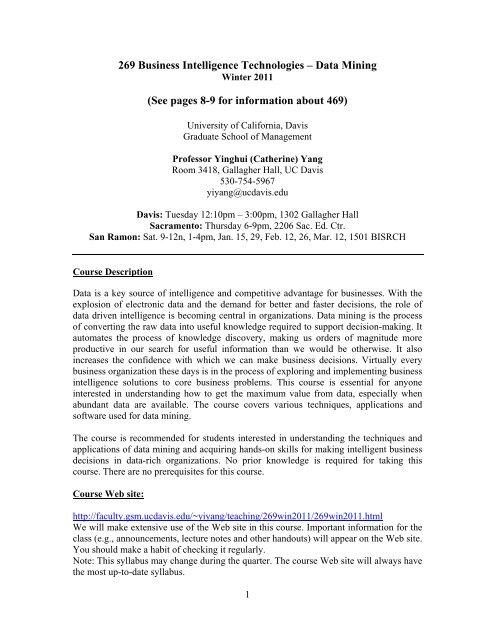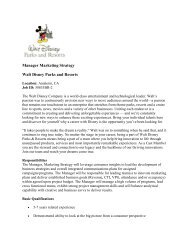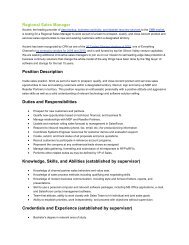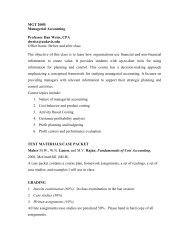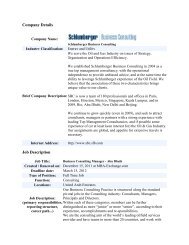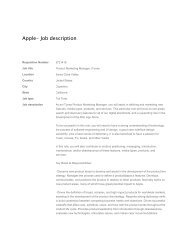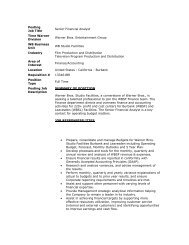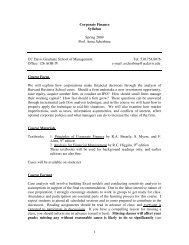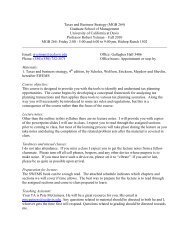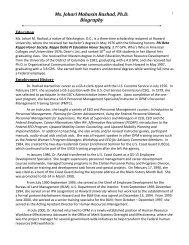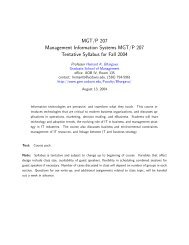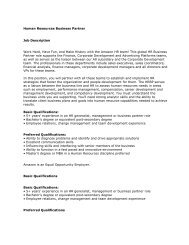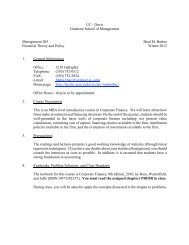269 Business Intelligence Technologies â Data Mining (See pages ...
269 Business Intelligence Technologies â Data Mining (See pages ...
269 Business Intelligence Technologies â Data Mining (See pages ...
You also want an ePaper? Increase the reach of your titles
YUMPU automatically turns print PDFs into web optimized ePapers that Google loves.
<strong>269</strong> <strong>Business</strong> <strong>Intelligence</strong> <strong>Technologies</strong> – <strong>Data</strong> <strong>Mining</strong>Winter 2011(<strong>See</strong> <strong>pages</strong> 8-9 for information about 469)University of California, DavisGraduate School of ManagementProfessor Yinghui (Catherine) YangRoom 3418, Gallagher Hall, UC Davis530-754-5967yiyang@ucdavis.eduDavis: Tuesday 12:10pm – 3:00pm, 1302 Gallagher HallSacramento: Thursday 6-9pm, 2206 Sac. Ed. Ctr.San Ramon: Sat. 9-12n, 1-4pm, Jan. 15, 29, Feb. 12, 26, Mar. 12, 1501 BISRCHCourse Description<strong>Data</strong> is a key source of intelligence and competitive advantage for businesses. With theexplosion of electronic data and the demand for better and faster decisions, the role ofdata driven intelligence is becoming central in organizations. <strong>Data</strong> mining is the processof converting the raw data into useful knowledge required to support decision-making. Itautomates the process of knowledge discovery, making us orders of magnitude moreproductive in our search for useful information than we would be otherwise. It alsoincreases the confidence with which we can make business decisions. Virtually everybusiness organization these days is in the process of exploring and implementing businessintelligence solutions to core business problems. This course is essential for anyoneinterested in understanding how to get the maximum value from data, especially whenabundant data are available. The course covers various techniques, applications andsoftware used for data mining.The course is recommended for students interested in understanding the techniques andapplications of data mining and acquiring hands-on skills for making intelligent businessdecisions in data-rich organizations. No prior knowledge is required for taking thiscourse. There are no prerequisites for this course.Course Web site:http://faculty.gsm.ucdavis.edu/~yiyang/teaching/<strong>269</strong>win2011/<strong>269</strong>win2011.htmlWe will make extensive use of the Web site in this course. Important information for theclass (e.g., announcements, lecture notes and other handouts) will appear on the Web site.You should make a habit of checking it regularly.Note: This syllabus may change during the quarter. The course Web site will always havethe most up-to-date syllabus.1
Textbook:<strong>Data</strong> <strong>Mining</strong> Techniques: ForMarketing, Sales, and CustomerRelationship Management, SecondEditionMichael Berry and Gordon Linoff,2004, Wiley, ISBN-10: 0471470643ISBN-13: 978-0471470649Software:We will use the database software Microsoft Access (optional) and a free data miningsoftware WEKA (download from http://www.cs.waikato.ac.nz/ml/weka). Noprogramming skill is needed.Office Hours: Knock on my door, make an appointment, or just give me a call.Grading:Components GradesClass Participation 15%Homework 60%Term Project 25%Participation: Make sure you read the cases carefully before each class, and activelyparticipate in discussion and offer insightful comments in class. The following scheme isused to grade student participation in each class:3: Excellent2: Good1: OK0: Absent with good reason and advance notification-3: Absent with no reasonHomework:There are 6 homework assignments in total. Each homework assignment may includeproblem solving, data analysis and case discussion. You should work on themindividually.2
Term Project:Each group is responsible for choosing a company to study its data utilization situation and makerecommendations about how its data should be used for generating business intelligence. Thereare two phases. In phase 1, which is due in the middle of the quarter, each group needs to turn in a2-3 page write-up about the company they picked and generally describe its data situation. In thelast class, each group presents its project to the entire class. In the final project report, each groupneeds to follow detailed guidelines to analyze the company’s data strategies, and make detailedrecommendations based on the techniques and strategies we learned from the class. Group sizecan vary between 1 ~ 3 students. <strong>See</strong> detailed term project description on Page 6.Class Schedule: (Subject to change)No. Davis Sac Bay Topic1 Jan 4 Jan 6 Jan 15 Course Introduction2 Jan 11 Jan 13 Jan 15 Modeling <strong>Data</strong> in Organizations3 Jan 18 Jan 20 Jan 29 Building <strong>Business</strong> <strong>Intelligence</strong> using Queries, <strong>Data</strong> Warehouse4 Jan 25 Jan 27 Jan 29 Market Basket Analysis & Association Rules, CRM5 Feb 1 Feb 3 Feb 12 Market Segmentation & Clustering, Prepare data6 Feb 8 Feb 10 Feb 12 Prediction & Classification – Decision Tree7 Feb 15 Feb 17 Feb 26 Personalization & Nearest Neighbor8 Feb 22 Feb 24 Feb 26 Financial Forecasting & Neural Networks9 Mar 1 Mar 3 Mar 12 Link Analysis & Web mining10 Mar 8 Mar 10 Mar 12 Term project presentationsDue Dates:Davis Sacramento BayHomework 1 Jan 11 Jan 13 Jan 29Homework 2 Jan 18 Jan 20 Jan 29Group Decision Jan 18 Jan 20 Feb 12Homework 3 Jan 25 Jan 27 Feb 12Homework 4 Feb 1 Feb 3 Feb 12Project Phase 1 Feb 1 Feb 3 Feb 26Homework 5 Feb 8 Feb 10 Feb 26Homework 6 Mar 1 Mar 3 Mar 12Final ProjectPresentationMar 8 Mar 10 Mar 12Final ProjectReportMar 15 Mar 17 Mar 19Note: Homework is due before class starts. Please hand in hard copies. You will get 20% less foryour grade for each day your homework is late (i.e. you get 0 after 5 days).3
Reading list:1. Course IntroductionCases:• A Case Study in <strong>Business</strong> <strong>Data</strong> <strong>Mining</strong> – Bank of America (textbook pp. 22-25)• A Wireless Communication Company Makes the Right Connections (textbook pp.34-39)• Neural Networks and Decision Trees Drive SUV Sales (textbook pp. 39-42)Textbook: Chapter 1, 2, 32. Modeling <strong>Data</strong> in OrganizationsTextpak:• Modeling <strong>Data</strong> in the Organization (available from Study.net)3. Building <strong>Business</strong> <strong>Intelligence</strong> using Queries, <strong>Data</strong> WarehouseOptional Reading:• Introduction to Structured Query Language (on course website)• Microsoft Access tutorial (link on course website)4. Market Basket Analysis, Association RulesTextbook: Chapter 4, 9Additional reading posted on course website5. Market Segmentation, ClusteringCases:• Clustering Town – The Boston Globe (textbook pp. 374-380)Textbook: Chapter 11, 176. Predication, Classification, Decision TreeTextbook: Chapter 6Additional reading posted on course website7. Personalization, k-Nearest NeighborsCases:• Polyphonic HMI: Mixing Music and Math (HBS case, available from Study.net)4
Textbook: Chapter 8, 128. Financial Prediction, Neural NetworksTextbook: Chapter 7Additional reading posted on course website9. Link Analysis, Web <strong>Mining</strong>, Search Engine MarketingCases:• MedNet.com Confronts “Click-Through” Competitionet (HBS case, available fromStudy.net)• Google Advertising (HBS case, available from Study.net)Textbook: Chapter 105
Term ProjectGrading:The term project in total counts 25% of the total grade.Phase 1 report: 5%Class presentation: 5%Final report: 15%This project is intended to provide you with valuable opportunity to be involved with acompany’s data-driven decisions. The main goal is to thoroughly understand how acompany leverages its data for business intelligence, and to connect what you learn fromthis class with the real problems in order to make valuable recommendations to thecompany. The project contains the following steps.Step 1: Form a groupPlease email me your decision by the due date.Step 2: Identify a company to studyThis company can be your previous employer, current employer or any other companythat is willing to discuss the related information with you.Step 3: Turn in Phase 1 reportEach group needs to turn in a 2-3 page write-up about the company they picked andgenerally describe its data situation. By the time you turn in your phase 1 report, youshould have a rough idea about the amount and depth of the information the companyallows you to access, and please describe that in the report too. Please turn in a hard copyof the report on the due date.Step 4: Class PresentationYour presentation should at least include the companies’ background, how its data ishandled, how business intelligence is generated from the data and your recommendations.Every member of the group should be involved in the presentation.Step 5: Turn in the final project reportWhen writing your final report, try to touch upon the 11 steps of data miningmethodology in Chapter 3 of the textbook, or use these steps to structure your report ifnecessary. Feel free to structure your report differently if you feel it can help you bringout the insights better. You can decide to focus more on the strategy side of data miningor technical side of data mining. When analyzing the current situation of the company,please discuss the strength and weakness of its current practice, and how business6
intelligence is derived from data. When making recommendations, please try to back upyour recommendations as much as possible. The report can also include information suchas the software used, data flow within the organization, and other valuable observations.You don’t need to do data analysis in order to fulfill the requirement of the project. If youare able to obtain the company’s data and have interests in analyzing them, you canchoose option 2 for 469.If you are able to finish your report before the last class, please give me a hard copybefore your class presentation. Otherwise, you can email me the report before the duedate.7
469469 is intended to build your hands-on experience based on the materials you learned in<strong>269</strong>. You can choose to do one of the two projects described below to fulfill therequirement of 469. The project can be done individually or in a group of 2-4 students.For each option, there are two phases. Phase 1 is due before the 7 th lecture. Phase 2 is dueone week after the last lecture.Option 1 (Using queries in a database to build business intelligence):This option is intended to provide you with valuable hands on experience in designingand implementing a real world database system application, and as such, you areencouraged to develop such a system to address managerial issues you face at your workplace. In this project, you should identify an application in your workplace and develop adatabase system for it. If you are not able to find a proper application related to yourwork, you should come and talk to me before you choose anything else.The project has 2 phases.Phase 1: <strong>Data</strong>base design1, Pick an application, describe the application.2, Why a database is needed for this application?3, Draw Entity-Relationship diagrams for the application. Indicate the assumptions andconstraints of the ER diagram. Convert the ER diagram to relational tables. Discuss thepossible problems of the design.Please turn in a 2-3 page report for this phase.Phase 2: Implementation in Microsoft Access.1, Properly refine your phase 1 according to my suggestions. You are allowed to makeother changes to phase 1 if desirable.2, Implement the tables in Microsoft Access.3, Populate the tables.4, Each group should write 5 queries. For each query, you should explain what businessintelligence can be derived. Please write your 5 most insightful queries.After you complete Phase 2, please submit your final project report. In the final reportyou turn in, you should clearly state the background of the application, the businessproblem you are addressing, the technical challenges you encountered, the design, thequeries, and the potential uses of the database. The focus of the report should be on thebusiness intelligence you can derive from your queries. For each query, please elaboratethe story behind it.8
When you submit the final report, please submit the Access file together with the Wordfile. Each group should only submit one copy of their report.Option 2 (Using data mining methods to build business intelligence):Each group identifies an application, and locates a relevant data set (you can acquire thedata set from a company or from the Internet), then further comes up with interestingquestions which can be answered based on the data set using data mining techniqueslearned in class. Finally, you should perform data analysis on the data set and reportresults.This option is intended to provide you with valuable hands on experience in designingand implementing a real world data mining application, and as such, you are encouragedto be involved in the entire data mining process including 1) find a problem/applicationthat interest you, 2) manage to get the data by yourself, 3) come up with questions thatare important to your problem/application, 4) use the techniques you learned in class toanswer those questions, 5) search for interesting patterns and models from the results, and6) evaluate your results.Phase 1 reportIn the report you submit, please include the following information:1) Description of the problem/application2) Description of the data set, names and description of the attributes3) Questions you want to address using data mining techniques4) The business value of your planned analysisPhase 2: Turn in the final project reportThe deliverable will be a report documenting data preparation, techniques used, modelsproduced, and evaluation of the models.When writing your final report, please provide as much details as possible about yourimplementation and solution. When you submit your final report, please also includeother files you want me to look at.Your final report will be evaluated by the intensity of your analysis, creativity of yourapproach, interpretation of your results, and the business insights.You might encounter a lot of problems when you start to process the data and buildmodels using the software, so please start early and ask me for advice when you havedifficulties.9


